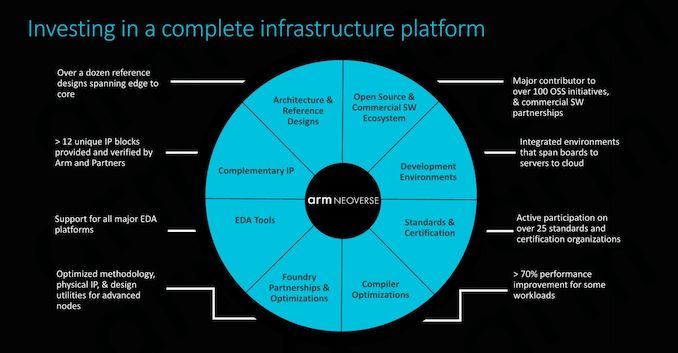Arm Announces Neoverse N1 & E1 Platforms & CPUs: Enabling A Huge Jump In Infrastructure Performance
by Andrei Frumusanu on February 20, 2019 9:00 AM ESTEnd Remarks: Strengthening the Infrastructure Ecosystem
If there’s one thing that readers should take away from today’s presentations, it’s the fact that Arm is taking the infrastructure and server push extremely seriously. The last year in particular has been transformative for the Arm ecosystem as we’ve for the first time seen Arm vendor platforms be competitive with the major incumbents such as Intel and AMD.
The elephant in the room is Amazon, and last year’s reveal of a new AWS instance based on their own-in house ARMv8 Graviton processors marked a significant moment showcasing that Arm is now irrefutably becoming mainstream in the industry.
While Arm did not divulge any information on who will be employing the new Neoverse N1 platforms first – I would not be surprised if the next generation Graviton processor will based on the N1 CPU.
The N1 CPU looks to be an excellent CPU that targets a sweet-spot point between peak compute performance, overall throughput. And most importantly it maintains the leading power efficiency that is already found in Arm's mobile products. Arm has high hopes for N1 and its eventual successors, and for good reason: they're looking to steal market share away from the likes of Intel (and x86 servers in general), which has proven to be an entrenched market full of very high performance processors. For that reason Arm is bringing their best to the table, and while N1 isn't going to be a core-for-core competitor with flagship x86, it stands to pose a significant threat, especially in workloads that can easily scale up to a larger number of cores.
Meanwhile the new E1 CPU targets the expanding market for high throughput processors, which with the upcoming shift to 5G will require more throughput performance at low power levels. Here Arm seems to have custom-tailored a CPU specifically to serve such use-cases. This is a move that's arguably less about stealing market share from any one player, and more about being in the right place at the right time to secure their place in what should be a rapidly growing market. In that sense the E1 is a very traditional Arm move – focus on cost and simpler processors – and this has been a move that's continued to serve Arm well over the years.
Although the new hardware IP is impressive, what also matters greatly is Arm’s efforts into strengthening the Arm software ecosystem. Working with various industry hardware and software partners in trying to facilitate the software stack and interoperability with Arm not only benefits vendors using Arm’s own hardware IP, but also vendors who chose the route of employing their own custom CPU and SoC designs. Similarly, those vendors who are trying to improve and strengthen their own products will inevitably feed back into strengthening the Arm ecosystem as well – creating essentially what is a group effort between many companies that in the future will continue to gain momentum.
It's said that the Neoverse N1 will be commercially deployed by partners in the next 12-18 months, and I think this will be a crucial moment for Arm and the company’s server endeavours. If the major breakthrough in mind-share hasn’t already happened, if all goes well and Arm and partners deliver on the promised improvements, the next 1-2 years will certainly represent a major shift in the industry.











101 Comments
View All Comments
platinumjsi - Thursday, February 21, 2019 - link
Wouldnt mind seeing an Anadtech article detailing the differences between X86 and Arm and explaining the benefits and downsides of each architecture.Looking at this if ARM can do 64 cores for 105w I have to wonder why it takes AMD 250w on the same process?
Intel / AMD should be seriously worried about this.
Could we see ARM-based Laptops / Desktops? Wouldnt be any good for gaming as I cant see devs recompiling there back cataloge for ARM but for Office use these seem ideal.
SarahKerrigan - Thursday, February 21, 2019 - link
ARM laptops already exist, running Windows. Look at the Asus NovaGo or the Lenovo Yoga C630.edzieba - Thursday, February 21, 2019 - link
ARM still has to overcome the same issue that killed off every other HPC architecture (barring POWER just about hanging in there): not being x86 ( http://3s81si1s5ygj3mzby34dq6qf-wpengine.netdna-ss... ).Antony Newman - Thursday, February 21, 2019 - link
Perhaps this will all change when Apple move over to an ARM ISA? Apple would have to offer a system that is at least as capable as x86 with a significantly lower lower TCO. I think the limitation up until know was the wimpiness of the ARM offerings; the offerings were cheap but not performant.javadesigner - Friday, February 22, 2019 - link
What does the "A" in ARM stand for ? I always thought it was Apple. Does Apple make any licensing money when Samsung makes an (A)pple(R)(M) chip ?TobiWahn_Kenobi - Saturday, February 23, 2019 - link
Acorn RISC MachinesTobiWahn_Kenobi - Saturday, February 23, 2019 - link
Nowadays Advances RISC Machines.darkich - Sunday, February 24, 2019 - link
.. Isn't this basically (as expected) an expansion of the Cortex A76 architecture?techbug - Sunday, June 9, 2019 - link
intel w-3175x's rate score doesn't look right. Its single-thread score is 48.18 and 56T is 729.82. So each thread only contributes only 729.82/56=13.03, which seems to be too low.obi210 - Sunday, February 2, 2020 - link
A Neoverse E1 derivative, without SMT, could be the next gen Arm little core. Such a core with Armv9 support could provide near A73 performance. In-order A53 derivatives should not be carried over to next gen.